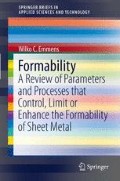Abstract
Comparing forming steel to construction steel illustrates the problem that arises when discussing formability: is it a material parameter in the strict sense?
Keywords
Until some time ago, steel grades were divided roughly into two categories: construction steel and forming steel. Construction steel was optimised for strength, and forming steel was optimised for formability, and the two categories were considered to be mutually exclusive. As an illustration: in construction steel the yield stress was made as high as possible (the higher the more expensive), and in forming steel the yield stress was made as low as possible (the lower the more expensive).
These two categories deserve some more investigation.
Construction steel is used for the manufacturing of constructions where the total strength is of importance. Consider for example a steel railway bridge. If the specifications state that the bridge must allow the passage of a 2000 ton train, then it is clear what the strength of the bridge must be. The strength of the construction as a whole is directly proportional to the strength of the material, and the latter can be measured in the laboratory easily, for example by performing a tensile test.
For forming steel the situation is not that simple. Forming steel is being used for the manufacturing of certain products, but the formability of the final product is of no importance. On the contrary, often the final product is expected not to have any (easy) formability at all. Of course there are exceptions: modern cars have crash zones that are designed to absorb energy. To do this the construction is expected to deform without fracture. Nevertheless, the formability property is related to the forming process, and not to the final formed product. This makes it more difficult to define formability as a property and to measure it in the laboratory (Chap. 13 discusses formability testing).
This comparison illustrates that formability is not a straightforward property as for example strength is. In fact, one can ask oneself the question:
Is formability really a material property in the strict sense? |
This work tries to answer that question, and discusses many other things related to formality as well. During our journey through formability land, the findings will be presented as a number of statements or conclusions.
Author information
Authors and Affiliations
Corresponding author
Rights and permissions
Copyright information
© 2011 Springer-Verlag Berlin Heidelberg
About this chapter
Cite this chapter
Emmens, W.C. (2011). Stating the Problem. In: Formability. SpringerBriefs in Applied Sciences and Technology. Springer, Berlin, Heidelberg. https://doi.org/10.1007/978-3-642-21904-7_2
Download citation
DOI: https://doi.org/10.1007/978-3-642-21904-7_2
Published:
Publisher Name: Springer, Berlin, Heidelberg
Print ISBN: 978-3-642-21903-0
Online ISBN: 978-3-642-21904-7
eBook Packages: EngineeringEngineering (R0)

